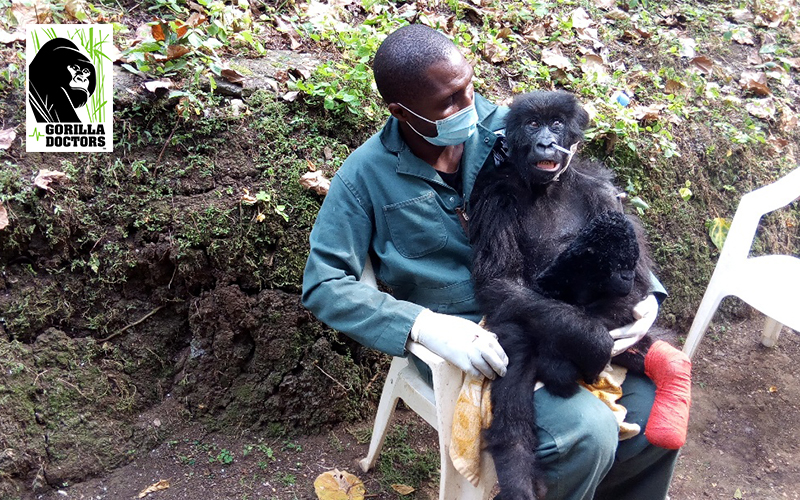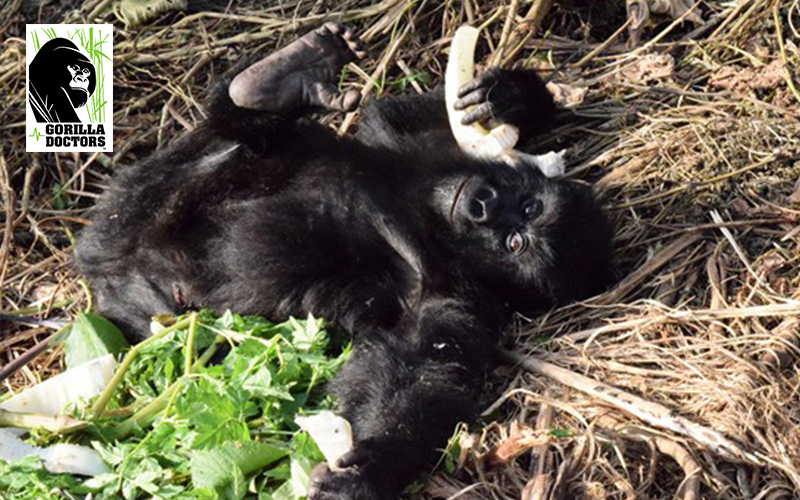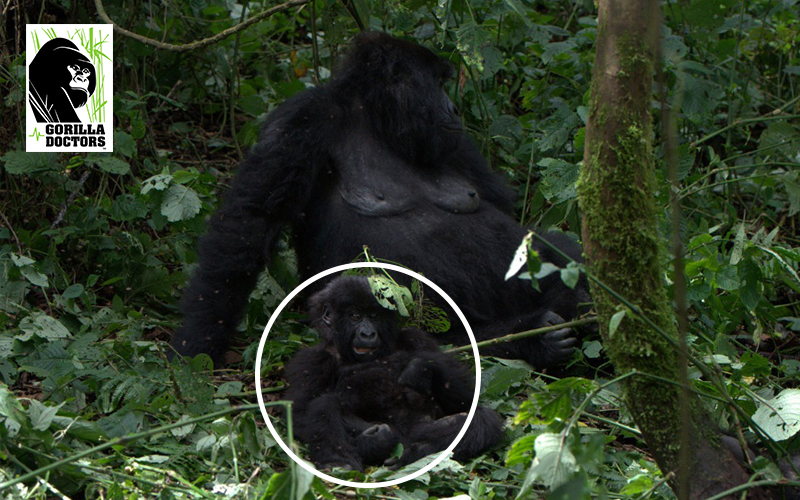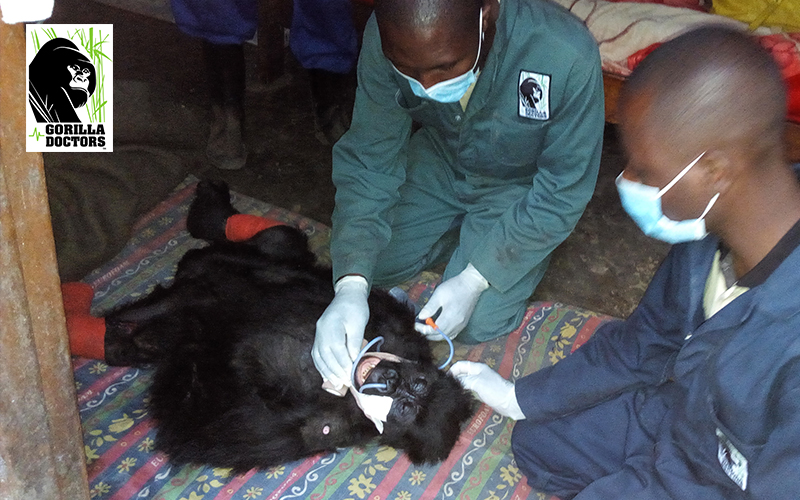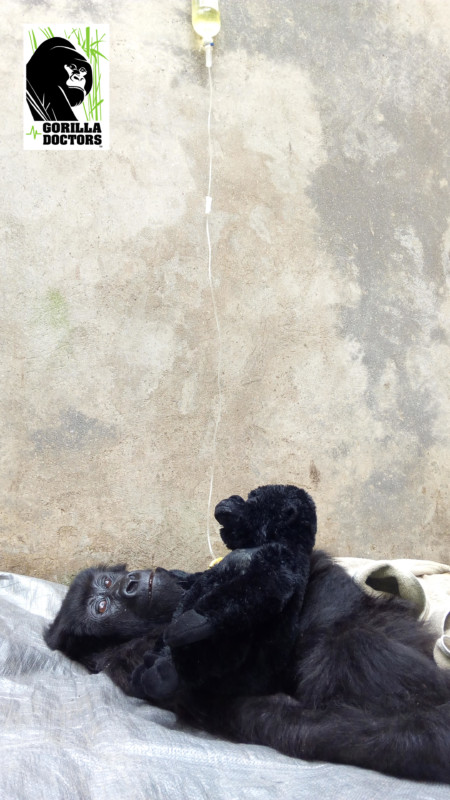Saving Baby Yalala
By Gorilla Doctors Staff on Thursday, June 22nd, 2017 in Blog.Dr. Eddy Kambale
On Monday afternoon, June 12 I received a phone call from the ICCN Chief warden Innocent reporting that the ranger team based at the GIKERI Patrol Post had called him about an infant gorilla caught in a snare. They believed the baby was from an unhabituated group, as there was no known habituated gorilla group ranging in that area the previous week.
Dr. Martin and I headed right away that same afternoon to Virunga National Park’s GIKERI post to join ICCN Monitoring Officer Jacques Katutu. Together we headed into the forest and found the infant an hour later. She was sitting on dry vegetation, with the only greenery anywhere near her being the fresh plant food brought to her by the rangers who found her when they saw her picking at the soil for food. Based on observations, it was clear that her group had made unsuccessful attempts to free her. We calculated that the baby gorilla had probably been caught in the snare for more than six days.
The baby was very weak, thin, with dry skin crusting on her left thigh, and lying on her back with a very tight rope snare on her left foot. She was too weak to sit up even at the sight of the food brought for her. Whenever she tried to sit up to eat she would fall backwards. When we approached her she started screaming and hiding her face, so in order to reduce her stress we sedated her with a low dose of an anesthetic. We conducted a quick physical exam: she was severely dehydrated, and upon checking her foot we found that the whole appendage had lost all its blood supply and was full of maggots.
While checking her nose print and skin lesions, we realized that this baby actually did belong to the habituated Kabirizi group and that her name was Yalala, who belonged to mother Mahisho. “Yalala” means “rubbish” in Swahili: everyone insisted we giver her a new name right away, but she was named after a Virunga National Park ranger who had died at the time she was born, so the name would stay.
After updating the Chief Park Warden Emmanuel de Merode about the situation, chief warden Innocent decided that the baby should be taken to the GIKERI post, so that they could attempt to reintroduce her into her group as soon as possible the following morning.
In the meantime, I knew that her foot would was extremely severe and that she was a great risk for a whole-body infection, so Dr. Martin and I decided it was going to be necessary to amputate the already-dead foot to prevent infection from spreading to the rest of her body. With baby Yalala under full anesthesia, we successfully completed the procedure and hiked out of the forest with her and the rangers just as it got dark.
But instead of taking Yalala to the ranger post at GIKERI that night, we took her to the ICCN-Virunga National Park station at Rumangabo so that we could provide her with safe and secure housing overnight. But the next morning, June 13, we saw that she had not eaten anything, and was perhaps even weaker than she had been when we first found her. If she had shown signs of getting stronger we would have taken her back to her group in the forest for reintroduction, but her condition was deteriorating rapidly. In consultation with the chief warden, we agreed that we should house her at the Senkwekwe Center’s quarantine facility.
At Senkwekwe we began working around the clock to warm and rehydrate her. She was so dehydrated that we couldn’t deliver fluids intravenously: instead, we placed a catheter that delivered fluids and glucose (for energy) into a bone marrow cavity. Within hours she began to show an improvement in her vital signs, which gave us hope that she would survive.
On Day 3, June 14, we started feeding her milk powder through a nasogastric feeding tube; a few hours later we were able to feed her some nice soup cooked at Mikeno Lodge. Fortunately baby Yalala tolerated the solid food, and she started to gain strength before our eyes. Our clearest indication that she was feeling better and getting stronger occurred on Day 7, June 17, when she bit me twice! She also started tugging at her nasogastric tube and nipping at her caregivers.
These behaviours were all cause for celebration.
Ensnarement, an unsuccessful struggle to get free of the snare, abandonment by her family when she couldnt’ be freed, starving for a week, exposure to the elements, rescue by strangers (humans), amputation of her foot, a new environment at Senkwekwe, subjection to a new diet, ongoing challenges especially now that she will be moving forward without a left foot…it all helped me understand and forgive her for her feisty behavior.
I worry for her future but am reassured by the amazing dedication of her caregiving team Babo and Philippe at Senkwekwe, as well as the assistance of Julie William of the Mikeno Lodge, all of which has made this very challenging case of Yalala successful.
Her story reminds me of a local saying: “Sometimes our life can look like the name we were given.”


 Donate
Donate
